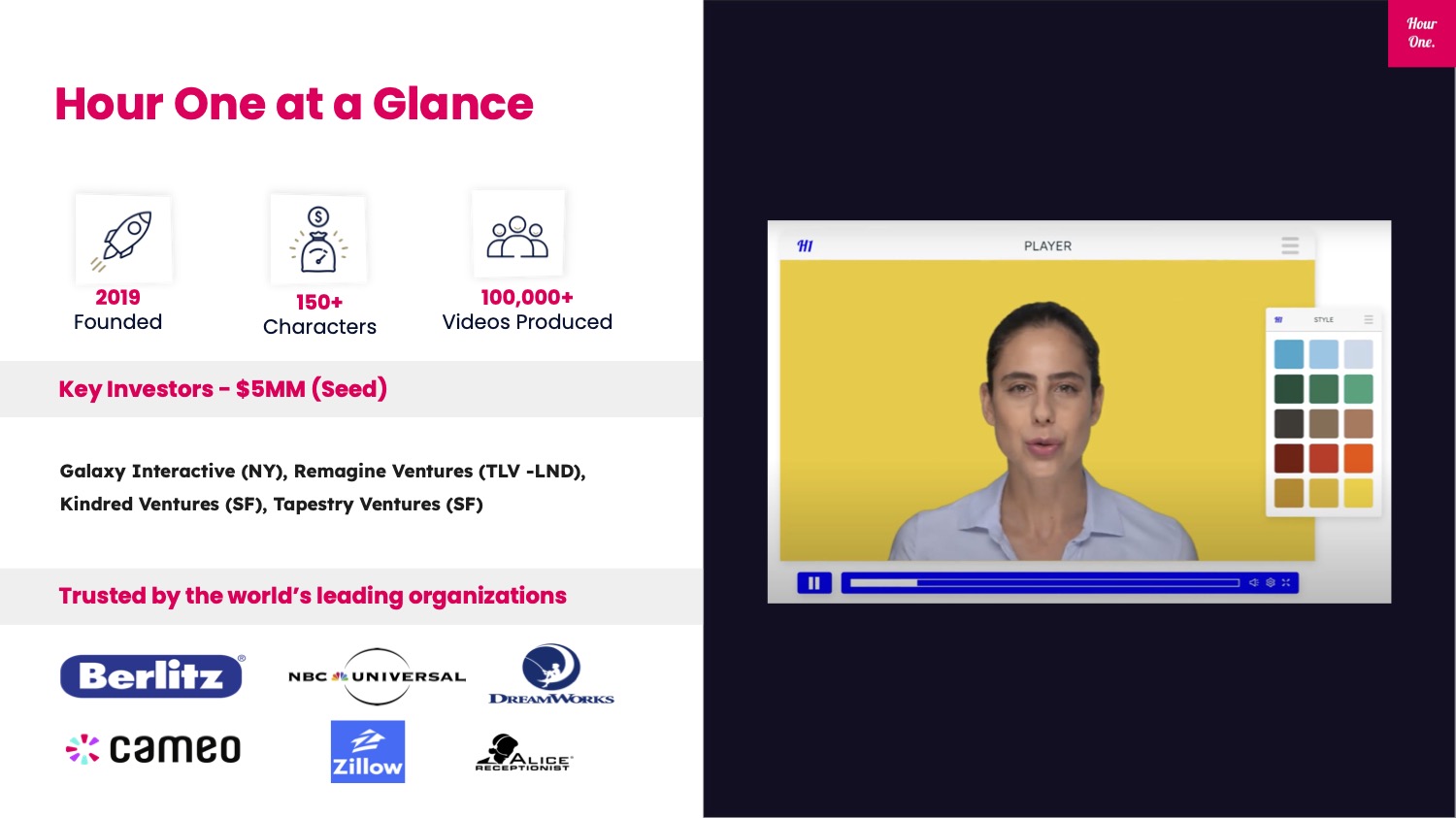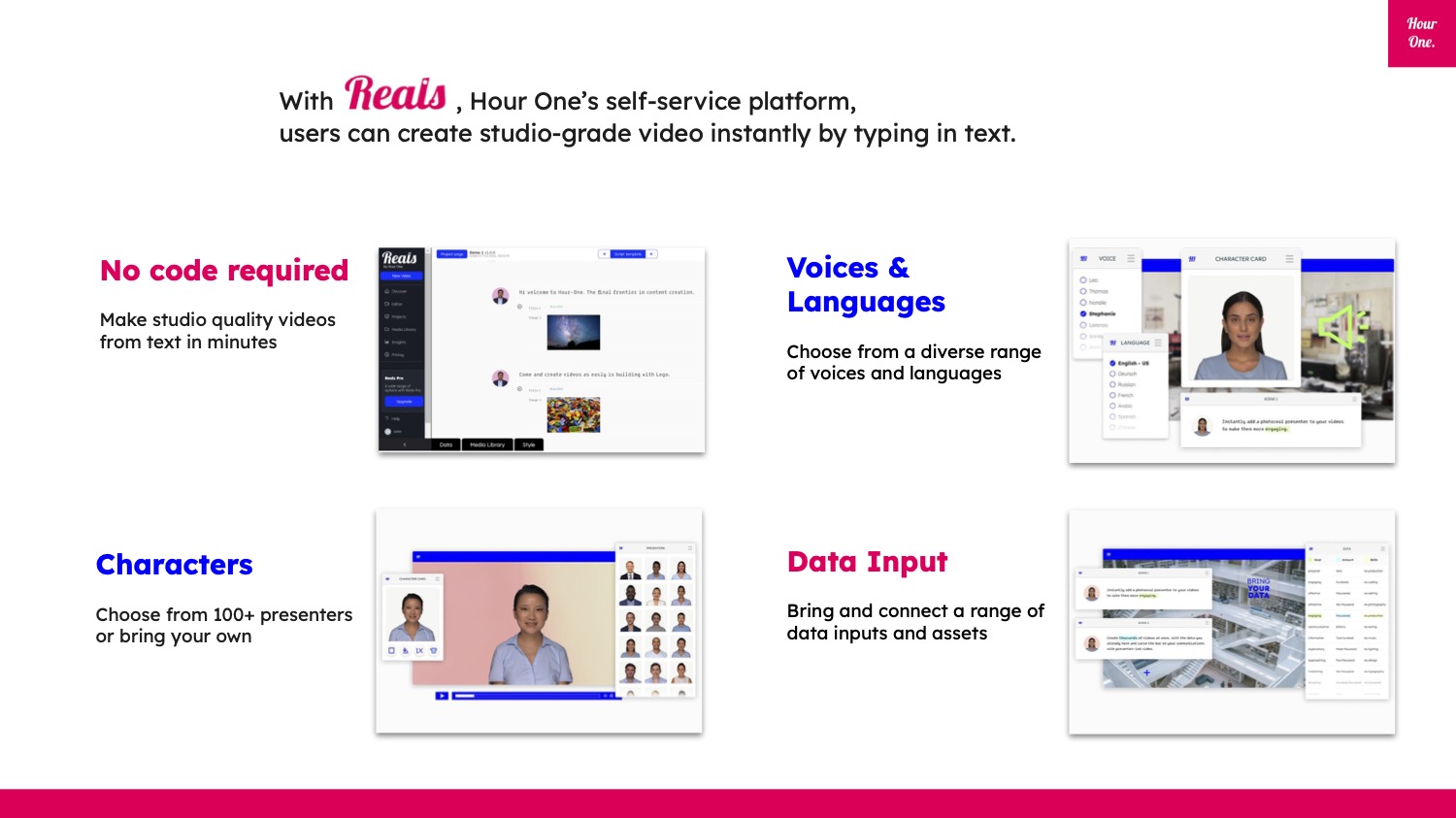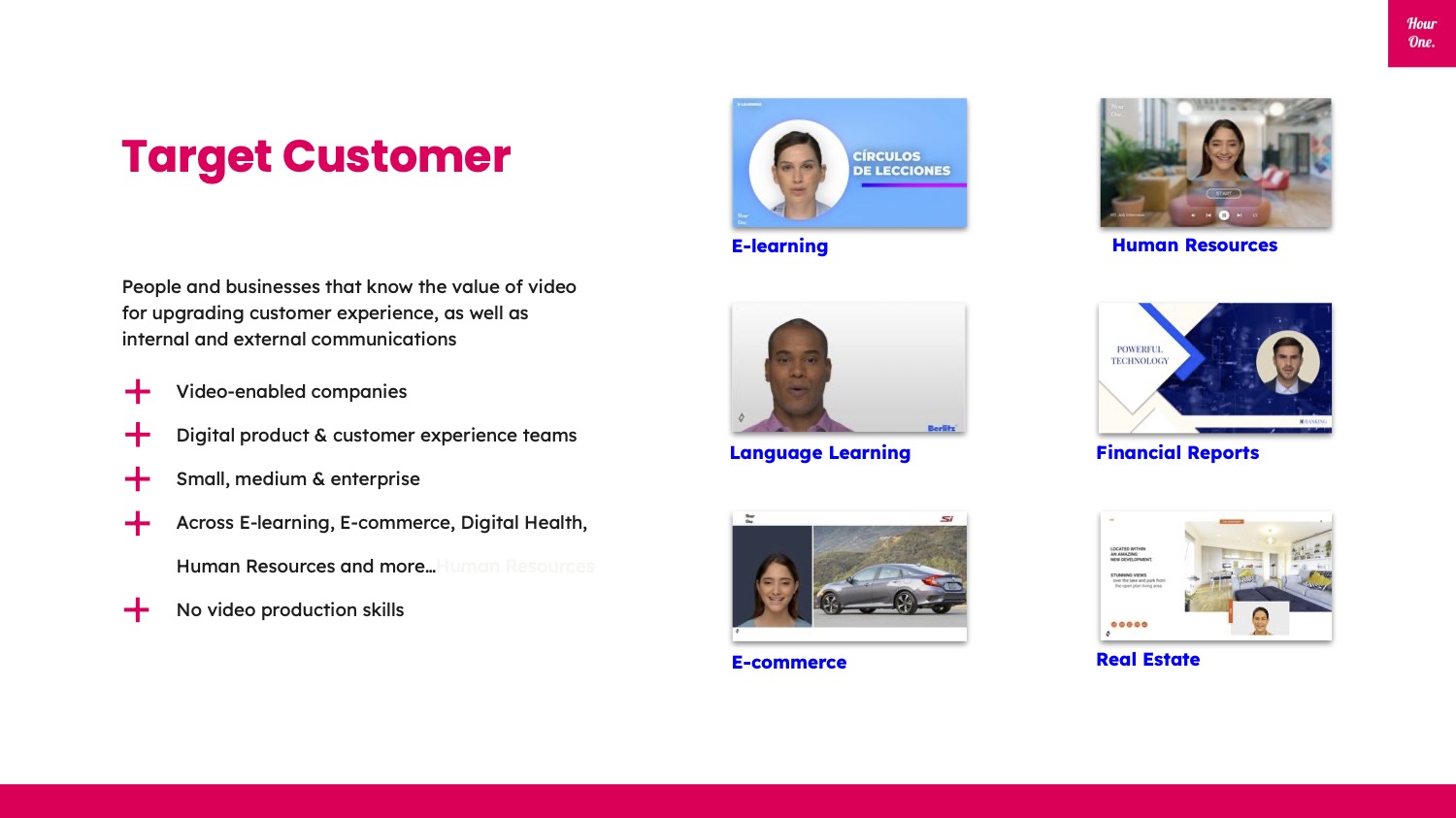Over the years, Mike Butcher has covered Hour One a number of times here on TechCrunch. The company is using AI to create text-to-video solutions with realistic-looking human avatars. The space seems to be exploding, and Hour One has been on quite the trajectory. The company raised $5 million back in 2020, was taking on the language learning vertical and raised another $20 million in a round that closed in April of this year.
I’m pretty excited to take a closer look at the deck Hour One used to raise its most recent round, so let’s dive right in!
We’re looking for more unique pitch decks to tear down, so if you want to submit your own, here’s how you can do that.
Slides in this deck
Hour One raised its $20 million round with a tight 11-slide deck. The company shared its deck, dated November 2021, in full, without edits or redactions, so we can see what the investors saw as they were reaching for their checkbooks.
- Cover slide
- “At a glance” summary slide
- Solution slide
- Market size slide
- Value proposition slide
- Product slide 1
- Product slide 2
- Target audience slide
- Case study slide
- Team slide
- Closing slide
Three things to love
I love a deck that is able to distill its story to the bare essentials. Most of the decks I’m seeing these days, both through my consulting practice and through the pitches submitted to TechCrunch, are a lot longer than the 11 slides Hour One used here. The question is … did they go too far into sparsity? Let’s find out!
Love the “at a glance” approach!

[Slide 2] This is a great approach to get everybody on the same page. Image Credits: Hour One
Let’s admit it: One of the main reasons startup founders need a deck in the first place is to help potential investors figure out whether they want to take a meeting with you. Having a summary slide can help investors figure out if you are in the right vertical and company stage — in other words, you can help them decide if you fit their investment thesis. This slide gets a few of those things right.
By leading with traction (characters and videos produced), customers and funding history, along with a screenshot showing how the interface works, this slide goes a long way toward setting the stage. Personally, I would have added a couple of additional points:
- A one-line summary about what the company does (“Human-like AI character videos at the click of a button” could work.)
- Make explicit the business model (B2B SaaS).
- Make explicit how much money you’re raising (“Raising $20 million Series A”).
The lesson here is to include all the pertinent information about your company in one place, as early in the story as possible.
Great product summary

[Slide 6] This is how you do a product summary. Image Credits: Hour One
Apart from the great pun in the name for its product, this slide is jam packed with really good content, offering a really clear summary of the product complexity Hour One has already built through a simple, user-focused story. To make this slide even better, I’d have preferred that the story was benefits driven rather than feature driven, but it does a lot of heavy lifting as-is.
The reason why benefit-driven product stories work better is obvious: You help the investor connect the dots. It isn’t about what the user can do, but about why they might do these things to save time, money and frustration. Here’s how that might have looked:
- No code required –> “Anyone can make AI character videos.”
- Voices and languages –> “Connect with your audience in their language.”
- Characters –> “Embrace diversity by choosing from more than 100 presenters.”
- Data input –> “Customized content on the fly by easily pulling in data from external sources.”
Incidentally, I’m confused about this slide: On the summary slide, we are talking about 150+ characters, and on this slide, it’s 100 presenters. Are presenters and characters different? If so, how? And if not, why are the numbers different? I presume that the founders would be able to talk about this more as they pitch the story, but it would have been better if it were more obvious why there’s a difference here.
A variety of target customers
The very best companies create a product that works well for one set of target users, and then expand the user base to capture a broader market share. Hour One tells that part of the story on its eighth slide:

[Slide 8] Target audiences. Image Credits: Hour One
What really works about this slide is that Hour One is able to show the breadth of its appeal; each of these categories could be big enough to build a successful company, but by being vertical agnostic, Hour One is able to build up a little fear of missing out (FOMO) in me as an investor: I can easily see how the company could be on an extraordinary growth trajectory.
Apparently, I’m in a nitpicking mood today, and as good and as clear as this slide is, I think it would be even better if they combined the target customers with their outcomes. Imagine how much stronger this part of the presentation would have been if the company had used actual case studies for each of these categories.
Here’s how that might look:
- E-commerce companies: +15% average basket value.
- Real estate: +19% of inquiries.
- Language learning: +40% vocab retention.
Obviously, I’m making up the numbers here, but as a founder, these are the kinds of slides where you can really show off how deep your market understanding is. Another approach might be to make it more benefits driven, connecting the customers with the use cases. “E-commerce uses Hour One to connect with customers” and “CFOs use Hour One to make their financial reports come to life.”
For a gold star, combine them for even deeper narratives: “Company X uses Hour One to make its internal training programs, resulting in a 35% increase in completion of new training initiatives.”
As a startup founder, what you can learn from this slide is to always be on the lookout for ways that you can show the depth of your knowledge, both in terms of domain expertise and market context. Understanding your customers deeply and that your product solves real problems for them is an indication that there’s something special about you and your team; being uniquely positioned to solve a problem becomes part of your “moat” — the reason why nobody else could be doing what you are doing.
In the rest of this teardown, we’ll take a look at three things Hour One could have improved or done differently, along with its full pitch deck!
Credit: Source link


Comments are closed.